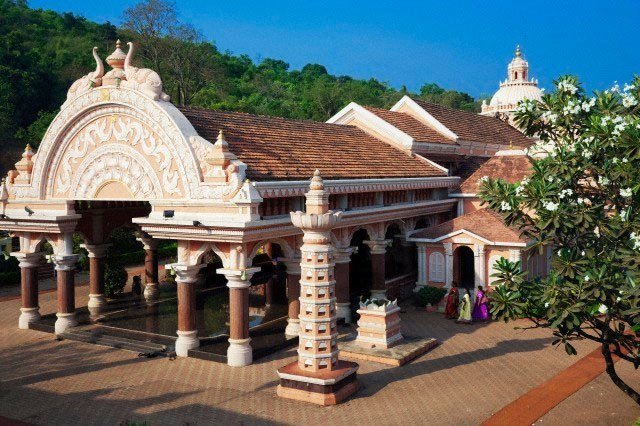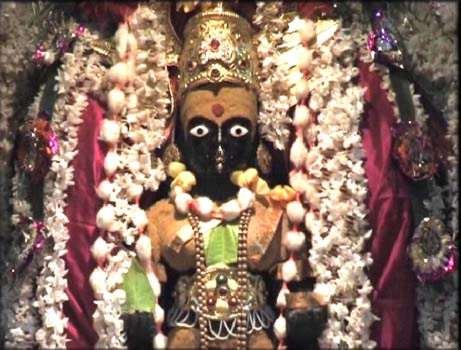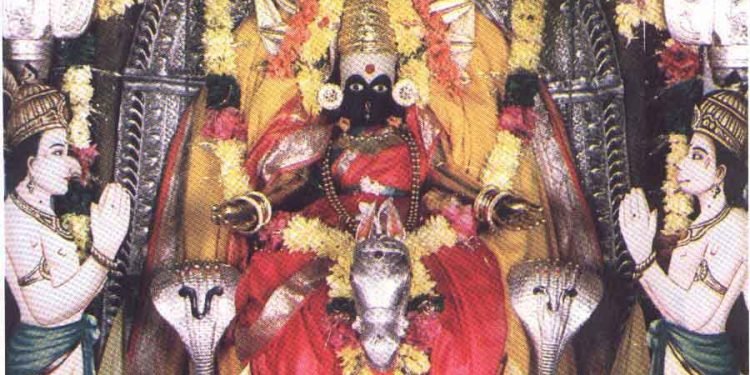Under the Portuguese rule,Portuguese relations with Hindus were sour. So in order to be grateful, Hindus built here a temple of Goddess “Mahalaxmi? as she is referred to as the goddess of peace.Hindus describe Mahalaxmi is a form of Mother of all Universes, who raised three super powers Brahma the creator, Vishnu the preserver and Shiva the destroyer.
Shrine’s History
Mahalaxmi is the Goddess of power and strength. She is believed to be an incarnation of Adishakti-the supreme power and energy. The Shaktas, among the Saraswats, worshipped Adishakti in the form of the linga. Many accept her as Pallavi, their supporting deity, believing that this Goddess of tremendous strength and power was released when the devas and rakshasas were churning the ocean for amrita . This was popularly known as the Amruthmanthan. The Saraswats, at the time of their arrival in Goa, were worshippers of ‘Shiva-Shakti’. While Shiva was represented by the ‘Linga’, Shakti was a Goddess. Thus Shri Mahalaxmi was their Goddess. This Goddess has been worshipped by the Shilahara rulers and the Kadamba Kings of Goa. This peaceful or Satvika form of devi has a unique feature, that she wears linga on her head.
Shri Mahalaxmi In addition to the black granite stone idol, there was also an Utsava idol made of ‘panchloha’ (five metals). Legend has it that during the inquisition in 1557, two non-Brahmins, Sapta and Phato, carried the Utsava idol in a box, while the granite idol was broken by the Portuguese. Sapta and Phato traveled by boat along the Arabian Sea, crossed the Rasai River and reached Talawal or Durbat in Atrunja, and handed over the idol to the Bhandiwade Mahalaxmi Temple. Sapta and Phato were rewarded by the Goddess who ordered the management to give them each two balls of rice after the mid-day mahapuja. This practice is carried out even today at a small hut constructed in memory of these two devotees. The Bhandiwade Mahalaxmi, which resembles the Mahalaxmi idol at Kolhapur in Maharashtra, has four arms. These arms hold a sickle, a club, a dagger, and a vessel containing prasad and flowers. Even today one can see the original stone idol at the centre of ‘Garbhagar’, while the small metal idol brought from Kolva is placed in the corner. The festival of Mahashivaratra is dedicated to the original deity, while of the Ram-navami is performed in honour of the deity from Colva. On that day, she is placed in the Maharath and taken into a procession. Apart from Shri Ram Navami , and Maha Shivaratri Festival in the month of Magha, Shri Mahalakshmi Pratishthapana Day in Vaishakha and Navaratri Festival in the month of Ashwin are also celebrated grandly. Shri Mahalaxmi Temple This is one of our ancient Kuladevata Temples.
When Lord Parashuram had invited our forefathers from Trihotrapura, they had come down to Goa with their deities of daily worship, which later became the Kulaswamis. Prominent among them were Shri Magirish Mahadev , Shri Mahalakshmi, Shri Mahalasa, Shri Shantadurga, Shri Nagesh and Shri Saptakotishwar. They were installed in different parts of Goa and when Shri Nagesh was installed in Bandiwade, Ponda it was believed that close to it, Shri Mahalakshmi temple was erected. some people believe that this Goddess was migrated from Kolvem village in Salcete taluka, during the persecution of Hindu temples by Portuguese rulers in the year 1540 to Bandivadem. Actually, Shri Mahalaxmi Temple was located in Bhandiwade during the historical time when Parashuram along with ten ‘Gotra’ Saraswat Brahmin Rishi migrated towards the South of India. This is as mentioned in the Shriskanda Puran Uttar Rahasya Sahayadri Khanda Prathmodhya.
On their arrival in Goa, the Saraswats, who had brought the Mahalaxmi idol with them, built a temple at Bhanda-Vatika or Bhandiwade village in the Atrunja or Ponda taluka. Most of the Saraswats, however, were then living at Tiswadi and Sasasti talukas and had to cross a river and travel a long distance to worship the deity. So they established at Kolva, just 6 km from Madgaon, another Mahalaxmi temple, on the banks of the Arabian Sea.The inscription of 1413 A.D. referred makes the mention of this Goddess and it means that at that time she was existing there. In fact, Shri Mahalaxmi of Colva was migrated from there first to Talaulim in Ponda taluka along with other deities and later on to Bandivadem. Other deities in the temple are Shri Narayan, Shri Baleshwar, Shri Ravalnath and Shri Narayan Purush.


Architectural Relevance of This Shrine
The Sabhamandap has a gallery of 18 images out of emanatory aspects of Bhagvata sect and this gallery is considered one of the rare galleries of wooden images of Vishnu in India. The speciality of this temple is its beautiful chowka which is famous for its grandeur and beauty. The Agrashala in the front and behind the temple as well as of the right side were constructed in the year of 1703 saka, Plava sanvatsar. The Agrashalas on the left side were constructed by Sarvashri Ramachandra Tata Naik Gaunekar and Panduranga Naik Namashikar while of the back side left was constructed by Narayan Laxman Naik Bhatkar and Sasashiva Naik Gaunekar. The ground floor of the present backside Agrashala was reconstructed in the year 1965 and the first floor was completed in 1970. It has 7 compartments on each floor. The Agrashala in front of the temple was constructed in the year 1937.
The reconstruction of the right side one took place in the year 1965. The construction of the building behind the temple on the right side was started in 1974. The inauguration of this new building took place on the 24th March 1974. The adjoining building has to be reconstructed. The temple has three halls for auspicious functions to celebrate like weddings, Thread Ceremony, Naming the child and other rites and rituals which are performed on inviting groups of people. The name of the halls is Mahalaxmi Hall, Rawalnath Hall, Narayan Dev Hall.
Shrine’s Map Location and How to Go There
By Road
You could easily get a bus toPonda Goa from anywhere from goa.
By Rail
Get down at the Karamboli or Margoa station and then take a bus to Ponda. Mahalaxmi is close to Ponda. You can hire a cab or Auto to get to Mahalaxmi Bandora.
By Air
Flight halt at Dabolim or Vasco then from there get a bus, auto or cab whichever convenient. As you arrive at Bandora. Mahalaxmi Temple is located close by.
Shrine Timings
7 AM to 8 PM
Events Celebrated at This Shrine
Chaitra Pournima in Chaitra in March/April
Ashadh Shudha Dashmi and Kartik Sudha Dashmi in July/ November respectively. Anant Chaturdashi in Badrapadh September Vaikunth Chaturdashi in Kartik November













































